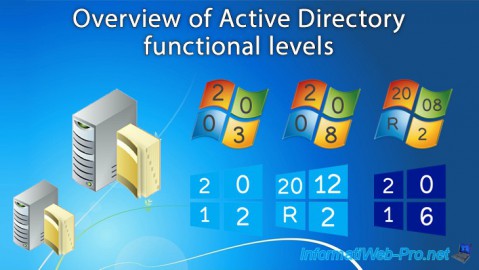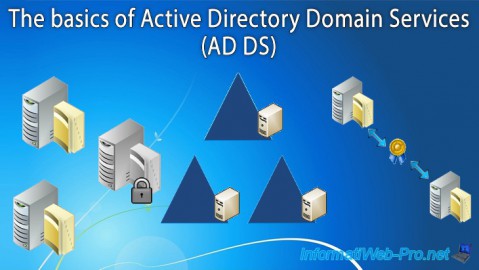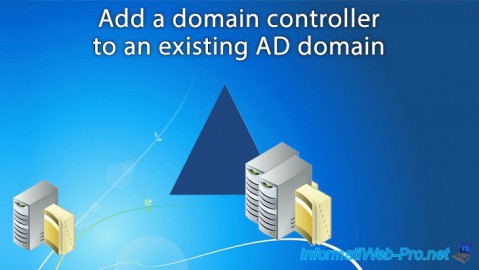Apply preferences (GPP) on your servers and/or client workstations via GPOs in an Active Directory infrastructure on Windows Server 2016
- Windows Server
- 01 October 2021 at 11:34 UTC
-

- 2/2
2.6. Create a network share
You can also create network shares on the client computer to make a folder on it accessible from the network.
To do this, go to "Network shares" and right click "New -> Network share".

2.7. Create a shortcut
You can also create a shortcut on the client computer by selecting "Shortcuts", then right clicking "New -> Shortcut".

In the shortcut properties that appear, you can :
- specify the name under which this shortcut will be displayed
- choose the target's type : file system object, URL or environment object. This allows you to create a shortcut to an existing file or to a web page if you wish.
- choose its location : desktop, start menu, startup, ...
- specify the target access path : the path of the target file or the address of the web page if the target type is "URL"
- specify arguments (parameters) : which is useful if the shortcut points to a program or a script
- set a hotkey for it if you want
- choose whether the program will be opened in a normal window, a window minimized in the taskbar (when it's launched) or in full screen (maximized window)
- specify a comment if you wish
- a path to an icon if you want to display a special icon for that shortcut

2.8. Control panel settings for the computer
Finally, you will also find a "Control Panel Settings" folder through which you can configure many settings :
- Data Sources : allows you to add new data sources by selecting the desired driver (ex : SQL Server)
- Devices : allows you to add new peripherals
- Folder Options : allows you to create new file type associations
- Local Users and Groups : allows you to create new local users or groups on the client PC
- Network Options : allows you to create new VPN connections or remote connections
- Power Options : allows you to manage the power options for computers running Windows XP or those running Windows 7 or later
- Printers : allows you to add a local printer or a network printer on the client PC
- Scheduled Tasks : allows you to create scheduled tasks (like in Windows) or immediate tasks
- Services : allows you to create new Windows services

3. User preferences
For user configuration, you will find almost the same preferences.
The only new preferences available are :
- Applications
- Drive Maps
- and other additional settings in the "Control Panel Settings" folder
3.1. Add a new application
In the "Applications" section, you can add new "application" type elements.
However, this requires the installation of a plug-in previously created by the developer of the concerned application.
For more information about this option, see the Microsoft site : Applications extension

3.2. Map a network drive
Using GPOs, you can easily map a network drive on the client computer through the "Drive Maps" section.
To create a new network drive, right click "New -> Mapped Drive" on the right side.

3.3. Control panel settings for the user
For user configuration, you will find almost the same settings for the control panel.
However, you will also find these :
- Internet Settings : allows you to configure the settings of Internet Explorer 5, 6, 7, 8, 9 and 10 using the same IE properties windows
- Regional Options : allows you to configure the language and country to be used, the date and time format, ...
- Start Menu : allows you to configure the various options available on Windows XP, but also on Windows Vista and later

4. Targeting
When you create a new preference, you will always find a "Common" tab where you can enable "Item-level targeting".
Once activated, click on the "Targeting" button.

The targeting editor is displayed.
Click on "New Item".

Although you can already target the computers receiving your GPO thanks to the organizational unit, the domain, the AD site, ... of which they are part, you can also use targeting at the level of each defined preference.
As you can see, this targeting editor will allow you to precisely target specific computers or users thanks to many criteria :
- computer name
- the speed of its processor
- free disk space
- its Active Directory domain
- the operating system used, as well as its version
- a specific registry key
- a custom WMI query
- and more
In this example, we will use the domain as a criterion.

As shown here, this targeting editor expects a NetBIOS domain name.
To find it more easily, you can click on the "..." button.

In the search results, select the desired NETBIOS domain.

The selected NETBIOS domain appears as the targeting criterion.

Then, you can add additional criteria by clicking on "New item" again.
As a second criterion, we will use the "operating system".

Select the product, edition, version, and computer role used as criteria.

Finally, you can also use a WMI query if you want.

To do this, all you need to do is specify a WMI query and the WMI namespace to use.

By default, when using multiple criteria, the selected operator is "AND".
Which means that all of these criteria must be true for the targeting result to be true.
However, you can change the type of condition by clicking on "Item Options" and choose between :
- "AND" or "OR"
- "Is" or "Not"

5. Sources
For detailed information about setting these preferences, see these pages available on Microsoft Docs :
- for the "Windows Settings" folder : Working with Windows Settings Preference Items Using the GPMC
- for the "Control Panel Settings" folder : Working with Control Panel Settings Preference Items Using the GPMC
Share this tutorial
To see also
-

Windows Server 4/16/2021
Windows Server - AD DS - How Active Directory replication works
-

Windows Server 4/30/2021
Windows Server - AD DS - Overview of Active Directory functional levels
-

Windows Server 4/3/2021
Windows Server - AD DS - The basics of Active Directory
-

Windows Server 5/21/2021
WS 2016 - AD DS - Add a domain controller to an existing AD domain

No comment